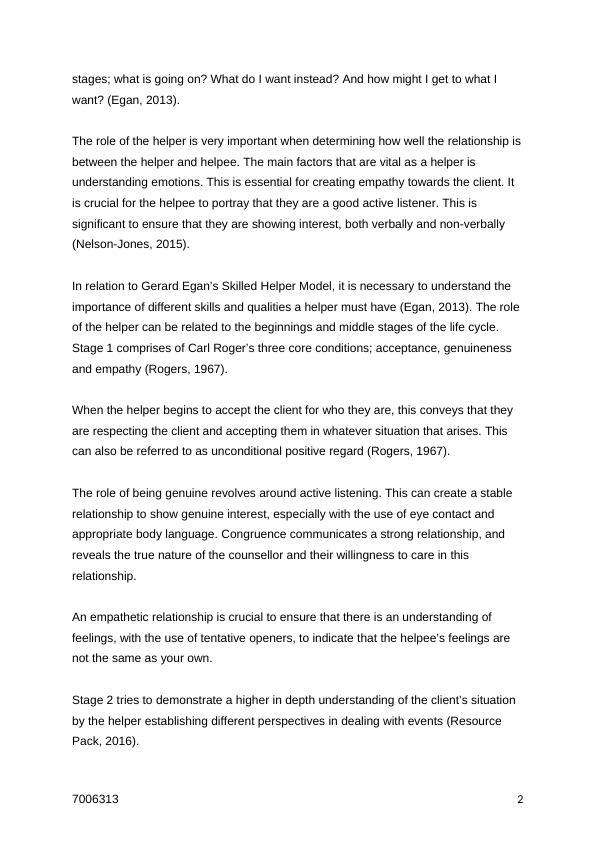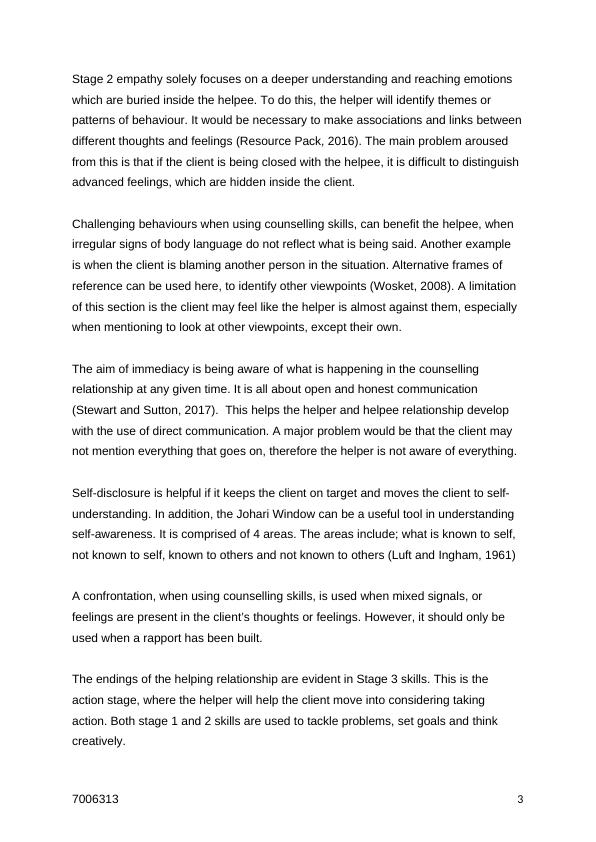Ask a question from expert
A245CAR: Intermediate Counselling Skills | Assignment
8 Pages2336 Words523 Views
Added on 2019-09-20
A245CAR: Intermediate Counselling Skills | Assignment
Added on 2019-09-20
BookmarkShareRelated Documents
A245CAR:IntermediateCounsellingSkillsWith reference to Egan's skilled helper model, identify the role of the helper, describing the life-cycle of this relationship and the helping and hindering factors in the formation of the relationship. Then reflecting upon your learning, evaluate your development of stage 1 and 2 counselling skills.SID: 7006313Word Count: 1646 wordsEgan’s skilled helper model will be described and evaluated throughout this work. The model aims to address three vital questions, which are revealed in the three 70063131

stages; what is going on? What do I want instead? And how might I get to what I want? (Egan, 2013).The role of the helper is very important when determining how well the relationship isbetween the helper and helpee. The main factors that are vital as a helper is understanding emotions. This is essential for creating empathy towards the client. It is crucial for the helpee to portray that they are a good active listener. This is significant to ensure that they are showing interest, both verbally and non-verbally (Nelson-Jones, 2015). In relation to Gerard Egan’s Skilled Helper Model, it is necessary to understand the importance of different skills and qualities a helper must have (Egan, 2013). The roleof the helper can be related to the beginnings and middle stages of the life cycle. Stage 1 comprises of Carl Roger’s three core conditions; acceptance, genuineness and empathy (Rogers, 1967).When the helper begins to accept the client for who they are, this conveys that they are respecting the client and accepting them in whatever situation that arises. This can also be referred to as unconditional positive regard (Rogers, 1967). The role of being genuine revolves around active listening. This can create a stable relationship to show genuine interest, especially with the use of eye contact and appropriate body language. Congruence communicates a strong relationship, and reveals the true nature of the counsellor and their willingness to care in this relationship.An empathetic relationship is crucial to ensure that there is an understanding of feelings, with the use of tentative openers, to indicate that the helpee’s feelings are not the same as your own. Stage 2 tries to demonstrate a higher in depth understanding of the client’s situation by the helper establishing different perspectives in dealing with events (Resource Pack, 2016). 70063132

Stage 2 empathy solely focuses on a deeper understanding and reaching emotions which are buried inside the helpee. To do this, the helper will identify themes or patterns of behaviour. It would be necessary to make associations and links betweendifferent thoughts and feelings (Resource Pack, 2016). The main problem aroused from this is that if the client is being closed with the helpee, it is difficult to distinguish advanced feelings, which are hidden inside the client. Challenging behaviours when using counselling skills, can benefit the helpee, when irregular signs of body language do not reflect what is being said. Another example is when the client is blaming another person in the situation. Alternative frames of reference can be used here, to identify other viewpoints (Wosket, 2008). A limitation of this section is the client may feel like the helper is almost against them, especially when mentioning to look at other viewpoints, except their own.The aim of immediacy is being aware of what is happening in the counselling relationship at any given time. It is all about open and honest communication (Stewart and Sutton, 2017). This helps the helper and helpee relationship develop with the use of direct communication. A major problem would be that the client may not mention everything that goes on, therefore the helper is not aware of everything.Self-disclosure is helpful if it keeps the client on target and moves the client to self-understanding. In addition, the Johari Window can be a useful tool in understanding self-awareness. It is comprised of 4 areas. The areas include; what is known to self, not known to self, known to others and not known to others (Luft and Ingham, 1961)A confrontation, when using counselling skills, is used when mixed signals, or feelings are present in the client’s thoughts or feelings. However, it should only be used when a rapport has been built.The endings of the helping relationship are evident in Stage 3 skills. This is the action stage, where the helper will help the client move into considering taking action. Both stage 1 and 2 skills are used to tackle problems, set goals and think creatively.70063133

End of preview
Want to access all the pages? Upload your documents or become a member.
Related Documents
Intermediate Counselling Skills | Helper Model Assignmentlg...
|8
|2020
|423
Gerard Egan’s Skilled Helper Model Case Study 2022lg...
|8
|1668
|35
Reflection Essay : Counselling Role Play.lg...
|7
|2014
|105
Assignment about Skilled Helpers Model.lg...
|7
|548
|37
Therapeutic Communication: Skills and Strategies for Effective Communicationlg...
|9
|2450
|119
Counselling Theory for Practice: Components, Stages, and Skillslg...
|6
|1209
|470